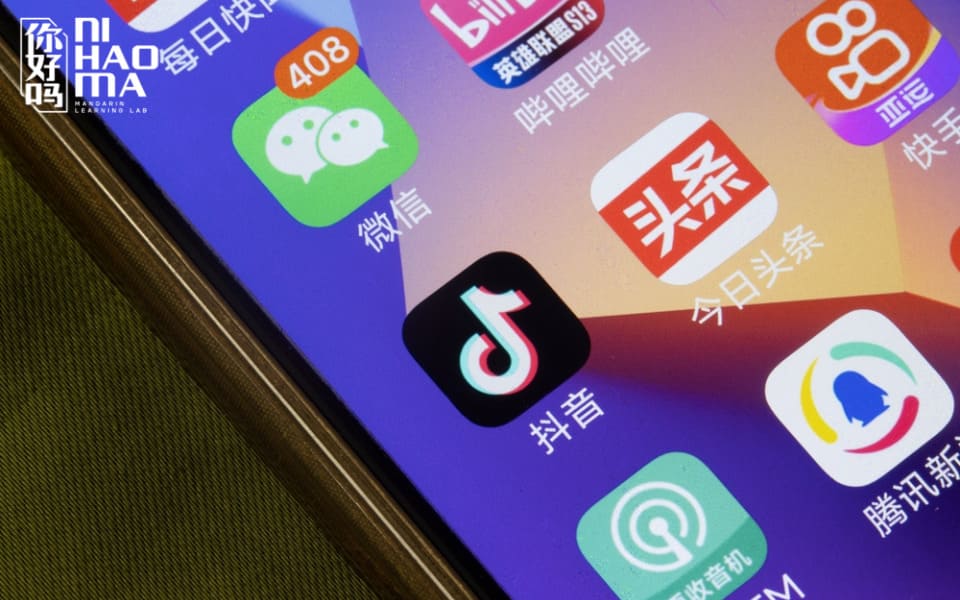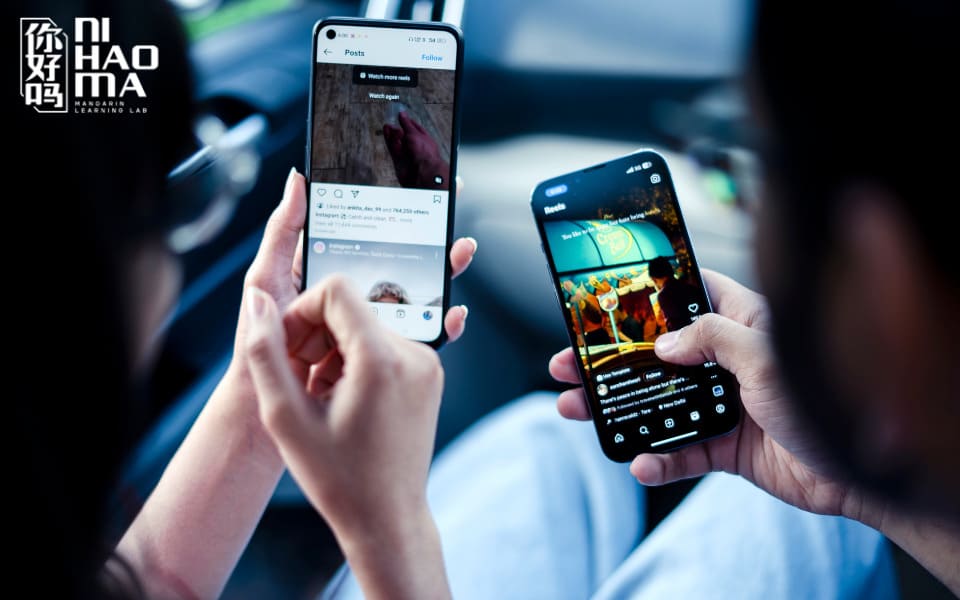In today’s digital age, social media has become an essential part of daily life. If you’re learning Chinese, mastering Chinese vocabulary for social media will make it much easier to chat with native speakers, follow trends, and interact naturally online. In this article, you’ll discover the most useful Chinese words and expressions related to social media — complete with real-life examples to help you use them with confidence!
Chinese Vocabulary for Social Media
To communicate naturally in the digital world, it’s important to know how to talk about social media platforms and online activities in Chinese. In this section, we’ll explore essential Chinese social media vocabulary that will help you confidently chat, post, and connect with friends, colleagues, and business partners from China.
Popular Social Media Platforms in Chinese
| Chinese | Pinyin | Meaning |
|---|---|---|
| 微信 | Wēixìn | WeChat – the largest messaging and social media app in China |
| 微博 | Wēibó | Weibo – a social platform similar to Twitter/X |
| 抖音 | Dǒuyīn | Douyin – the Chinese version of TikTok for short videos |
| 快手 | Kuàishǒu | Kuaishou – another popular short video-sharing platform |
| 哔哩哔哩 | Bīlībīlī | Bilibili – a youth-favorite video site similar to YouTube |
| 小红书 | Xiǎo Hóng Shū | Xiaohongshu (RED) – a lifestyle and fashion sharing platform |
| 知乎 | Zhīhū | Zhihu – a Q&A community like Quora |
| A long-standing messaging and social platform by Tencent | ||
| 豆瓣 | Dòubàn | Douban – a site for reviewing movies, books, and music |
| 百度贴吧 | Bǎidù tiēbā | Baidu Tieba – topic-based discussion forums |
| 人人网 | Rénrén wǎng | Renren – a social network similar to Facebook, popular with students |
| 优酷 | Yōukù | Youku – a video-sharing platform similar to YouTube |
| 腾讯视频 | Téngxùn shìpín | Tencent Video – Tencent’s movie and video streaming service |
| 搜狐视频 | Sōuhú shìpín | Sohu Video – another major online video platform in China |
| 脸书 | Liǎnshū | Facebook – not widely used in Mainland China |
| 照片墙 | Zhàopiàn qiáng | Instagram – not widely used in Mainland China |
| 油管 | Yóuguǎn | YouTube – not widely used in Mainland China |
| 推特 | Tuītè | Twitter – not widely used in Mainland China |

Chinese Vocabulary for Social Media Activities
| Chinese | Pinyin | Meaning |
|---|---|---|
| 登录 | dēnglù | Log in |
| 注册 | zhùcè | Sign up / register |
| 发帖 / 发布动态 | fātiě / fābù dòngtài | Post or update a status |
| 上传照片 | shàngchuán zhàopiàn | Upload photos |
| 上传视频 | shàngchuán shìpín | Upload videos |
| 点赞 | diǎn zàn | Like / give a thumbs-up |
| 评论 | pínglùn | Comment |
| 回复 | huífù | Reply to a comment |
| 转发 | zhuǎnfā | Share / repost |
| 收藏 | shōucáng | Save / bookmark |
| 关注 | guānzhù | Follow |
| 粉丝 | fěnsī | Follower / fan |
| 私信 | sīxìn | Direct message / inbox |
| 添加好友 | tiānjiā hǎoyǒu | Add a friend |
| 拉黑 | lāhēi | Block someone |
| 举报 | jǔbào | Report a post or account |
| 修改资料 | xiūgǎi zīliào | Edit profile |
| 更换头像 | gēnghuàn tóuxiàng | Change profile picture |
| 浏览 | liúlǎn | Browse / scroll |
| 搜索 | sōusuǒ | Search |
| 点开链接 | diǎn kāi liànjiē | Click on a link |
| 发评论 | fā pínglùn | Post a comment |
| 发消息 | fā xiāoxī | Send a message |
| 删除 | shānchú | Delete (a post or comment) |
| 登出 | dēngchū | Log out |
| 直播 | zhíbō | Livestream |
| 观看直播 | guānkàn zhíbō | Watch a livestream |
| 视频通话 | shìpín tōnghuà | Video call |
| 上传故事 | shàngchuán gùshì | Post a story |
| 评论区 | pínglùn qū | Comment section |
Chinese Vocabulary for Social Media Features
| Chinese | Pinyin | Meaning |
|---|---|---|
| 功能 | gōngnéng | Feature / function |
| 菜单 | càidān | Menu |
| 主页 | zhǔyè | Homepage / personal profile |
| 动态 | dòngtài | Post / status update |
| 消息 | xiāoxī | Message / notification |
| 通知 | tōngzhī | Notification |
| 点赞按钮 | diǎn zàn ànniǔ | Like button |
| 分享按钮 | fēnxiǎng ànniǔ | Share button |
| 关注按钮 | guānzhù ànniǔ | Follow button |
| 收藏夹 | shōucáng jiá | Favorites / saved items |
| 搜索栏 | sōusuǒ lán | Search bar |
| 聊天窗口 | liáotiān chuāngkǒu | Chat window |
| 视频号 | shìpín hào | Video account / channel |
| 评论功能 | pínglùn gōngnéng | Comment feature |
| 私信功能 | sīxìn gōngnéng | Private messaging feature |
| 推送 | tuī sòng | Content recommendation / feed |
| 话题标签 | huàtí biāoqiān | Hashtag / topic tag |
| 直播间 | zhíbō jiān | Livestream room |
| 滤镜 | lǜjìng | Filter |
| 表情包 | biǎoqíng bāo | Sticker pack / emoji set |
| 评论点赞 | pínglùn diǎnzàn | Like a comment |
| 转发功能 | zhuǎnfā gōngnéng | Repost / share feature |
| 删除功能 | shānchú gōngnéng | Delete feature |
| 编辑资料 | biānjí zīliào | Edit personal profile |
| 上传功能 | shàngchuán gōngnéng | Upload feature |
| 举报按钮 | jǔbào ànniǔ | Report button |
| 登出功能 | dēngchū gōngnéng | Log-out function |
| 语言设置 | yǔyán shèzhì | Language settings |
| 隐私设置 | yǐnsī shèzhì | Privacy settings |
| 夜间模式 | yèjiān móshì | Dark mode |
| 推广功能 | tuīguǎng gōngnéng | Advertising / promotion feature |
| 通讯录同步 | tōngxùn lù tóngbù | Sync contacts |
| 举报功能 | jǔbào gōngnéng | Report function |

Chinese Vocabulary for Social Media
| Chinese | Pinyin | Meaning |
|---|---|---|
| 网红 | wǎnghóng | Internet celebrity / influencer |
| 粉丝 | fěnsī | Fan / follower |
| 博主 | bózhǔ | Blogger |
| 网民 | wǎngmín | Netizen / internet user |
| 内容创作者 | nèiróng chuàngzuò zhě | Content creator |
| 视频号 | shìpín hào | Video channel |
| 话题 | huàtí | Topic / hashtag |
| 热搜 | rèsōu | Hot search |
| 网络暴力 | wǎngluò bàolì | Cyberbullying |
| 虚拟形象 | xūnǐ xíngxiàng | Virtual avatar / digital persona |
| 网名 | wǎngmíng | Online nickname / username |
| 动态 | dòngtài | Post / status |
| 置顶 | zhìdǐng | Pin a post |
| 私信 | sīxìn | Direct message (DM) |
| 通知 | tōngzhī | Notification |
| 粘贴 | zhāntiē | Paste (copy & paste) |
| 上传 | shàngchuán | Upload |
| 下载 | xiàzǎi | Download |
| 关注者 | guānzhù zhě | Follower |
| 取消关注 | qǔxiāo guānzhù | Unfollow |
| 转发量 | zhuǎnfā liàng | Number of shares |
| 表情符号 | biǎoqíng fúhào | Emoji |
| 内容推荐 | nèiróng tuījiàn | Content recommendation |
| 互动 | hùdòng | Interaction |
| 合拍 | hépāi | Duet (in video apps) |
| 挑战赛 | tiǎozhàn sài | Challenge (online contest) |
| 上热门 | shàng rèmén | Go trending |
| 网络爆红 | wǎngluò bàohóng | Go viral |
| 直播间 | zhíbō jiān | Livestream room |
| 弹幕 | dànmù | Floating comments on videos |
| 账号被封 | zhànghào bèi fēng | Account banned or blocked |
| 举报 | jǔbào | Report |
| 修改资料 | xiūgǎi zīliào | Edit profile |
| 添加好友 | tiānjiā hǎoyǒu | Add friend |
| 社交圈 | shèjiāo quān | Social circle / friend zone |
| 网络趋势 | wǎngluò qūshì | Online trend |
| 网传 | wǎng chuán | Internet rumor / online buzz |
| 回复 | huífù | Reply |
| 收藏 | shōucáng | Save / bookmark |
| 屏蔽 | píngbì | Mute / hide post |
| 拉黑 | lāhēi | Block user |
| 账号登陆 | zhànghào dēnglù | Log in to account |
| 退出登陆 | tuìchū dēnglù | Log out |
| 视频推荐 | shìpín tuījiàn | Recommended videos |
| 算法 | suànfǎ | Algorithm |
| 刷视频 | shuā shìpín | Scroll videos |
| 刷评论 | shuā pínglùn | Scroll comments |
| 沉迷网络 | chénmí wǎngluò | Addicted to social media |
| 社交账号 | shèjiāo zhànghào | Social media account |
Dialogues Using Chinese Vocabulary for Social Media
In the digital age, social media has become an inseparable part of our lives. If you’re learning Chinese, mastering Chinese vocabulary for social media will help you start conversations, comment on posts, and keep up with the latest online trends. In this article, you’ll find practical dialogue examples that show you how to chat naturally like a native speaker – staying on trend while improving your vocabulary effortlessly!
Dialogue 1: When the Social Media App Crashes
A: 你的小红书今天能打开吗?
Nǐ de Xiǎohóngshū jīntiān néng dǎkāi ma?
Can you open your Xiaohongshu app today?
B: 打不开啊,一直显示“网络错误”。
Dǎ bù kāi a, yīzhí xiǎnshì “wǎngluò cuòwù”.
No, it keeps showing “network error.”
A: 我也是,上传视频失败了好几次。
Wǒ yě shì, shàngchuán shìpín shībài le hǎo jǐ cì.
Same here — I’ve tried uploading a video several times but failed.
B: 听说是服务器崩了,很多人都在吐槽呢。
Tīngshuō shì fúwùqì bēng le, hěn duō rén dōu zài tǔcáo ne.
I heard the server crashed — everyone’s complaining about it online.

Dialogue 2: Your Friend’s New Post
A: 你看到小王的新动态了吗?
Nǐ kàn dào Xiǎo Wáng de xīn dòngtài le ma?
Did you see Xiao Wang’s new post?
B: 看到了,他发了好多旅游照片。
Kàn dào le, tā fā le hǎoduō lǚyóu zhàopiàn.
Yeah, he posted a bunch of travel photos.
A: 风景太漂亮了,我已经点赞和收藏了。
Fēngjǐng tài piàoliang le, wǒ yǐjīng diǎnzàn hé shōucáng le.
The scenery is stunning — I already liked and saved the post.
B: 我也想去那个地方,下次我们一起吧!
Wǒ yě xiǎng qù nàgè dìfāng, xiàcì wǒmen yīqǐ ba!
I want to visit that place too — let’s go together next time!

Dialogue 3: Livestream Shopping
A: 最近你有没有看那个主播的直播?
Zuìjìn nǐ yǒu méiyǒu kàn nàgè zhǔbō de zhíbō?
Have you watched that streamer’s livestream lately?
B: 看了!他带货太厉害了,几分钟就卖完上万件商品。
Kàn le! Tā dàihuò tài lìhài le, jǐ fēnzhōng jiù mài wán shàng wàn jiàn shāngpǐn.
Yes! He’s amazing at selling — thousands of items sold out in just a few minutes.
A: 对啊,我都被种草了,昨天还下单了一支口红。
Duì a, wǒ dōu bèi zhòngcǎo le, zuótiān hái xiàdān le yī zhī kǒuhóng.
Right? He totally influenced me — I ordered a lipstick yesterday.
B: 哈哈,现在直播太有影响力了,连我妈都在看。
Hāhā, xiànzài zhíbō tài yǒu yǐngxiǎnglì le, lián wǒ mā dōu zài kàn.
Haha, livestreaming is so powerful now — even my mom watches it!
Conclusion
With this article by Ni Hao Ma, you would feel more confident using Chinese vocabulary for social media in real-life conversations. Whether you’re chatting with Chinese friends, commenting on posts on Weibo or Douyin, or exploring trending topics online, these words and phrases will help you connect more naturally. Keep reviewing the vocabulary daily and practice using it in real contexts — that’s the best way to remember it longer and sound more fluent in Chinese!



